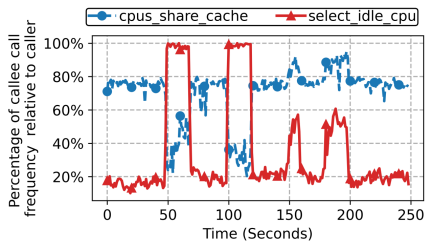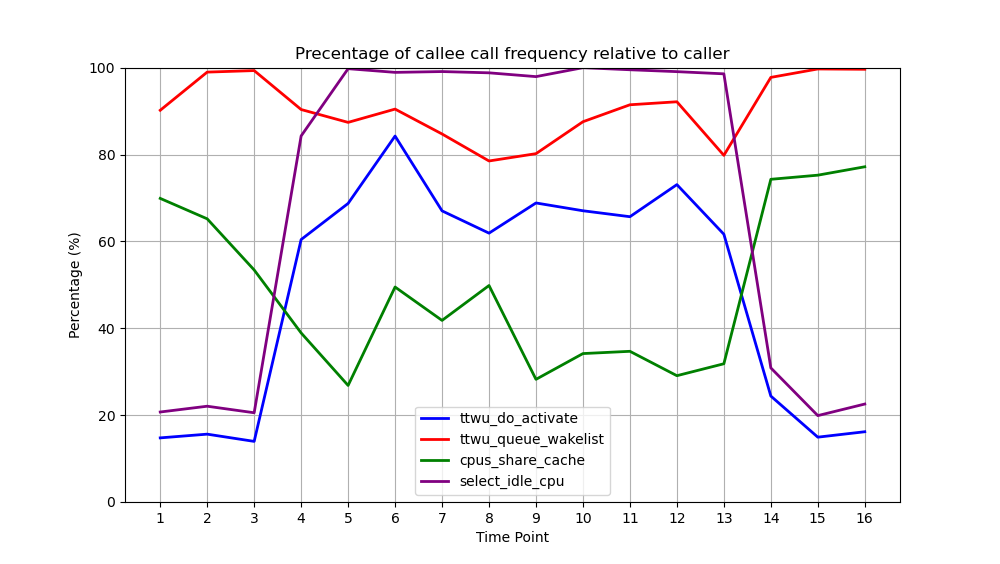调用栈占比分析评判性能瓶颈
在内核函数中,使用callee(被调用者)占caller(调用者)的调用比例(或者反过来,caller占callee的比例)是一种简单而可行的分析干扰情况的方法。
当存在某种干扰时,会存在某些调用栈中某callee占caller比例增、减、从有到无或从无到有的可能性(也可能反过来,某caller占callee比例增、减、从有到无或从无到有)。
我们使用5.15.0的内核进行实验,验证该方法的可行性与有效性。
可行性分析
- 如下图所示,图中展示了
select_idle_sibling调用的两个关键函数的调用占比在干扰影响下变化,左半select_idle_cpu调用占比上升、cpus_share_cache调用占比下降的部分是发生CPU干扰,右半select_idle_cpu和cpus_share_cache调用占比均提升的部分是发生了LLC干扰。在CPU干扰时,select_idle_sibling选目标核时会产生明显的select_idle_cpu调用次数的上升,达到几乎100%。

- 如下图所示,左半是发生CPU干扰时的调用占比,右半是没有CPU干扰时的调用占比。发生干扰时,
psi_task_change会更频繁地被ttwu_do_activate调用,使得psi_task_change作为caller占psi_group_change的占比提升

这些调用占比的增减是否是一种偶然?还是与实际干扰的发生有强逻辑相关性?上述的例子已经足以支撑该方法在CPU干扰情况下的可行性,下面的内容将验证调用栈占比分析评判性能瓶颈的方法在CPU干扰情况下的有效性。
有效性分析
psi_task_change和select_idle_sibling的父调用链上都有try_to_wake_up,应该从其基本逻辑出发开始分析
ftrace的function_graph相关调用栈如下所示:
15) |try_to_wake_up() {
15) 0.195 us | // ...
15) | select_task_rq_fair() {
15) 0.431 us | // ...
15) | select_idle_sibling() {
15) 0.182 us | available_idle_cpu();
15) 0.314 us | select_idle_cpu();
15) 1.146 us | }
15) 0.185 us | // ...
15) 3.627 us | }
15) 0.587 us | // ...
15) | ttwu_do_activate() {
15) | psi_task_change() {
15) 0.191 us | psi_flags_change();
15) 0.217 us | // ...
15) 0.723 us | psi_group_change();
15) 0.199 us | // ...
15) 0.295 us | psi_group_change();
15) 0.211 us | // ...
15) 0.299 us | psi_group_change();
15) 0.191 us | // ...
15) 3.993 us | }
15) + 10.187 us | // ...
15) + 20.704 us | }
15) 0.190 us | // ...
15) + 27.971 us |}下面我们来看看两种调用栈占比变化的详细分析:
先将try_to_wake_up的主要调用栈用伪代码的形式展示。
伪代码表示的该部分代码的调用栈,其中大部分与C语言无异,将函数的实现全部嵌套方便查看和理解,并将需要区分形参和实参的地方用冒号进行区分(冒号左半边为形参,右半边为实参):
int try_to_wake_up(struct task_struct *p, unsigned int state, int wake_flags) {
// ...
cpu = (int select_task_rq(struct task_struct *p, int prev_cpu: p->wake_cpu, int wake_flags: wake_flags | WF_TTWU) {
// ...
int select_task_rq_fair(struct task_struct *p, int prev_cpu, int wake_flags) {
// 在CPU干扰中,不会出现WF_SYNC,因为这是同步唤醒——即在wakee被唤醒同时使得waker睡眠
// 这是任务协作才会有的情况(例如:互斥锁之间就可以使用WF_SYNC来互相唤醒)
// 因此,sync在CPU干扰中恒为false
int sync = (wake_flags & WF_SYNC) && !(current->flags & PF_EXITING);
struct sched_domain *tmp;
// ...
int cpu = smp_processor_id();
// ...
for_each_domain(cpu, tmp) {
// ...
if (cpu != prev_cpu)
new_cpu = (int wake_affine(struct sched_domain *sd: tmp, struct task_struct *p, int this_cpu: cpu,
int prev_cpu: prev_cpu, int sync: sync));
// ...
}
// ...
if (wake_flags & WF_TTWU) {
/* Fast path */
new_cpu = (int select_idle_sibling(struct task_struct *p, int prev: prev_cpu, int target: new_cpu));
}
}
});
if (task_cpu(p) != cpu) {
if (p->in_iowait) {
delayacct_blkio_end(p);
atomic_dec(&task_rq(p)->nr_iowait);
}
wake_flags |= WF_MIGRATED;
psi_ttwu_dequeue(p);
set_task_cpu(p, cpu);
}
// ...
void ttwu_queue(struct task_struct *p, int cpu, int wake_flags) {
struct rq *rq = cpu_rq(cpu);
struct rq_flags rf;
if (ttwu_queue_wakelist(p, cpu, wake_flags))
return;
rq_lock(rq, &rf);
update_rq_clock(rq);
ttwu_do_activate(rq, p, wake_flags, &rf);
rq_unlock(rq, &rf);
}
// ...
}select_idle_sibling相关调用栈分析
重点不光在于理顺唤醒某一任务的执行流,更重要在于在发生CPU干扰的时候,try_to_wake_up内部被调用函数的调用占比和调用频次所产生的变化的原因分析。

图中左半部分是CPU干扰下调用占比的变化,右半部分则是LLC干扰下调用占比的变化。
可以看到:
- 在发生CPU干扰的情况下,
select_idle_cpu的调用占比猛增到接近100%,而cpus_share_cache的调用占比降低; - 在发生LLC干扰的情况下,
select_idle_cpu和cpus_share_cache的调用占比都增加,但都没有达到100%。
select_idle_sibling的具体实现:
static int select_idle_sibling(struct task_struct *p, int prev, int target)
{
bool has_idle_core = false;
struct sched_domain *sd;
unsigned long task_util, util_min, util_max;
int i, recent_used_cpu;
/*
* On asymmetric system, update task utilization because we will check
* that the task fits with cpu's capacity.
*/
if (sched_asym_cpucap_active()) {
sync_entity_load_avg(&p->se);
task_util = task_util_est(p);
util_min = uclamp_eff_value(p, UCLAMP_MIN);
util_max = uclamp_eff_value(p, UCLAMP_MAX);
}
/*
* per-cpu select_idle_mask usage
*/
lockdep_assert_irqs_disabled();
if ((available_idle_cpu(target) || sched_idle_cpu(target)) &&
asym_fits_cpu(task_util, util_min, util_max, target))
return target;
/*
* If the previous CPU is cache affine and idle, don't be stupid:
*/
if (prev != target && cpus_share_cache(prev, target) &&
(available_idle_cpu(prev) || sched_idle_cpu(prev)) &&
asym_fits_cpu(task_util, util_min, util_max, prev))
return prev;
/*
* Allow a per-cpu kthread to stack with the wakee if the
* kworker thread and the tasks previous CPUs are the same.
* The assumption is that the wakee queued work for the
* per-cpu kthread that is now complete and the wakeup is
* essentially a sync wakeup. An obvious example of this
* pattern is IO completions.
*/
if (is_per_cpu_kthread(current) &&
in_task() &&
prev == smp_processor_id() &&
this_rq()->nr_running <= 1 &&
asym_fits_cpu(task_util, util_min, util_max, prev)) {
return prev;
}
/* Check a recently used CPU as a potential idle candidate: */
recent_used_cpu = p->recent_used_cpu;
p->recent_used_cpu = prev;
if (recent_used_cpu != prev &&
recent_used_cpu != target &&
cpus_share_cache(recent_used_cpu, target) &&
(available_idle_cpu(recent_used_cpu) || sched_idle_cpu(recent_used_cpu)) &&
cpumask_test_cpu(p->recent_used_cpu, p->cpus_ptr) &&
asym_fits_cpu(task_util, util_min, util_max, recent_used_cpu)) {
return recent_used_cpu;
}
/*
* For asymmetric CPU capacity systems, our domain of interest is
* sd_asym_cpucapacity rather than sd_llc.
*/
if (sched_asym_cpucap_active()) {
sd = rcu_dereference(per_cpu(sd_asym_cpucapacity, target));
/*
* On an asymmetric CPU capacity system where an exclusive
* cpuset defines a symmetric island (i.e. one unique
* capacity_orig value through the cpuset), the key will be set
* but the CPUs within that cpuset will not have a domain with
* SD_ASYM_CPUCAPACITY. These should follow the usual symmetric
* capacity path.
*/
if (sd) {
i = select_idle_capacity(p, sd, target);
return ((unsigned)i < nr_cpumask_bits) ? i : target;
}
}
sd = rcu_dereference(per_cpu(sd_llc, target));
if (!sd)
return target;
if (sched_smt_active()) {
has_idle_core = test_idle_cores(target, false);
if (!has_idle_core && cpus_share_cache(prev, target)) {
i = select_idle_smt(p, sd, prev);
if ((unsigned int)i < nr_cpumask_bits)
return i;
}
}
i = select_idle_cpu(p, sd, has_idle_core, target);
if ((unsigned)i < nr_cpumask_bits)
return i;
return target;
}CPU干扰下select_idle_sibling选核频繁调用select_idle_cpu的分析
select_idle_sibling频繁调用select_idle_cpu的唯一可能是:select_idle_sibling的快速选核策略都失败了。
快速选核策略主要判断要选中的核是否idle以及该核是否与目标CPU共享LLC缓存,在CPU干扰存在的情况下,快速选核策略的失败显然更容易发生(某个CPU是idle的可能性更低),故而更频繁地调用select_idle_cpu。
比较图中左半部分和右半部分,可以知道:CPU干扰下select_idle_cpu占比达到了接近100%,这说明CPU干扰导致了各个核都有严重的计算资源占用,很难再获取到idle的CPU; 而LLC干扰下select_idle_cpu只是一定程度的升高,没有达到完全找不到idle状态CPU的情况。
CPU干扰下select_idle_sibling选核调用cpus_share_cache频次下降的分析
cpus_share_cache是用于判断两个核是否共享LLC缓存的函数,主要是在条件判断中被调用。 其他条件逻辑与该条件时,只要前面的条件不满足就不会调用cpus_share_cache(逻辑短路)。
在select_idle_sibling中,cpus_share_cache的调用主要有三处:
- 选
prev对应的CPU的情况,判断prev是否和target共享LLC缓存
/*
* If the previous CPU is cache affine and idle, don't be stupid:
*/
if (prev != target && cpus_share_cache(prev, target) &&
(available_idle_cpu(prev) || sched_idle_cpu(prev)) &&
asym_fits_cpu(task_util, util_min, util_max, prev))
return prev;- 任务的
recent_used_cpu并非prev和target的情况,判断recent_used_cpu和target是否共享LLC
/* Check a recently used CPU as a potential idle candidate: */
recent_used_cpu = p->recent_used_cpu;
p->recent_used_cpu = prev;
if (recent_used_cpu != prev &&
recent_used_cpu != target &&
cpus_share_cache(recent_used_cpu, target) &&
(available_idle_cpu(recent_used_cpu) || sched_idle_cpu(recent_used_cpu)) &&
cpumask_test_cpu(p->recent_used_cpu, p->cpus_ptr) &&
asym_fits_cpu(task_util, util_min, util_max, recent_used_cpu)) {
return recent_used_cpu;
}- 开启超线程后,没有idle状态的核的前提下,获得
prev核的超线程,判断prev和target是否共享LLC
if (sched_smt_active()) {
has_idle_core = test_idle_cores(target, false);
if (!has_idle_core && cpus_share_cache(prev, target)) {
i = select_idle_smt(p, sd, prev);
if ((unsigned int)i < nr_cpumask_bits)
return i;
}
}注:服务器上关闭了超线程,所以这个分支是不可能进入的
在考虑缓存亲和性的调度场景下,select_idle_sibling中得到的目标CPU来自于wake_affine。
static int wake_affine(struct sched_domain *sd, struct task_struct *p,
int this_cpu, int prev_cpu, int sync)
{
int target = nr_cpumask_bits;
if (sched_feat(WA_IDLE))
target = wake_affine_idle(this_cpu, prev_cpu, sync);
if (sched_feat(WA_WEIGHT) && target == nr_cpumask_bits)
target = wake_affine_weight(sd, p, this_cpu, prev_cpu, sync);
schedstat_inc(p->stats.nr_wakeups_affine_attempts);
if (target != this_cpu)
return prev_cpu;
schedstat_inc(sd->ttwu_move_affine);
schedstat_inc(p->stats.nr_wakeups_affine);
return target;
}分析wake_affine中得到的new_cpu,可以得知:
wake_affine_idle是选择旧CPU和目标CPU中空闲的一个CPU,二者均不空闲则会进入wake_affine_weight继续判断。
在CPU干扰严重时,会更加频繁地进入wake_affine_weight(即wake_affine_idle失败),这是因为更难获得idle的this_cpu和prev_cpu
wake_affine_weight主要比较this_cpu和prev_cpu之间的负载情况。
static int
wake_affine_weight(struct sched_domain *sd, struct task_struct *p,
int this_cpu, int prev_cpu, int sync)
{
s64 this_eff_load, prev_eff_load;
unsigned long task_load;
this_eff_load = cpu_load(cpu_rq(this_cpu));
if (sync) {
unsigned long current_load = task_h_load(current);
if (current_load > this_eff_load)
return this_cpu;
this_eff_load -= current_load;
}
task_load = task_h_load(p);
this_eff_load += task_load;
if (sched_feat(WA_BIAS))
this_eff_load *= 100;
// 这里乘以capacity_of是为了平衡两个CPU的负载
// load是根据nice值算出来的,与CPU的能力强弱无关
// 所以在load一定的情况下,强的CPU负载更轻
// 为了公平地完成两个CPU的负载比较,应该乘以对方CPU的能力
this_eff_load *= capacity_of(prev_cpu);
prev_eff_load = cpu_load(cpu_rq(prev_cpu));
prev_eff_load -= task_load;
if (sched_feat(WA_BIAS))
prev_eff_load *= 100 + (sd->imbalance_pct - 100) / 2;
prev_eff_load *= capacity_of(this_cpu);
/*
* If sync, adjust the weight of prev_eff_load such that if
* prev_eff == this_eff that select_idle_sibling() will consider
* stacking the wakee on top of the waker if no other CPU is
* idle.
*/
if (sync)
prev_eff_load += 1;
return this_eff_load < prev_eff_load ? this_cpu : nr_cpumask_bits;
}计算负载时利用该CPU的cfs_rq->avg.load_avg(该CPU的调度队列上所有调度实体的平均负载之和)得到this_eff_load和prev_eff_load。
比较两个CPU的负载大小前,this_eff_load加上当前任务负载task_load,而prev_eff_load减去当前任务负载task_load。 在CPU干扰严重时,所有CPU的负载接近相等,此时prev_eff_load减去task_load;this_eff_load加上task_load后,this_eff_load < prev_eff_load的可能性就更小了,进而导致选核this_cpu失败概率上升,使得CPU干扰严重时,prev_cpu被选中的概率上升
调用cpus_share_cache的情况1要求prev != target,根据上述分析,CPU干扰严重时,更有可能prev == target。
psi_task_change调用变频繁的分析
PSI是Pressure Stall Information。它是内核中的一个性能分析工具。
以任务的粒度,在存在其他任务CPU争用、内存缺页、IO阻塞、irq阻塞等瓶颈时会统计记录系统中存在的被阻塞任务数。
在try_to_wake_up的相关调用栈中,ttwu_queue内会调用ttwu_do_activate,进而调用psi_task_change。故而重点分析ttwu_queue的内部逻辑。
static void ttwu_queue(struct task_struct *p, int cpu, int wake_flags)
{
struct rq *rq = cpu_rq(cpu);
struct rq_flags rf;
if (ttwu_queue_wakelist(p, cpu, wake_flags))
return;
rq_lock(rq, &rf);
update_rq_clock(rq);
ttwu_do_activate(rq, p, wake_flags, &rf);
rq_unlock(rq, &rf);
}其中ttwu_do_activate内部调用了psi_task_change,所以,psi_task_change的调用频次高低,关键在于if判断条件ttwu_queue_wakelist是否为true。
在进入代码解释前,可以先从实验入手分析结果。 下图的数据提供了在没有干扰和CPU干扰下ttwu_do_activate和ttwu_queue_wakelist的调用相对于ttwu_queue的占比:

从4s到13s之间是加入了CPU干扰的情况,可以看出,ttwu_queue_wakelist的调用占比没有明显变化,但ttwu_do_activate调用占比明显增加。
这说明ttwu_queue_wakelist是相对CPU干扰不敏感的调用,而ttwu_do_activate/psi_task_change则是CPU干扰敏感的。
从源码层面分析可以得出这个数据的原因:
static bool ttwu_queue_wakelist(struct task_struct *p, int cpu, int wake_flags)
{
if (sched_feat(TTWU_QUEUE) && ttwu_queue_cond(p, cpu)) {
sched_clock_cpu(cpu); /* Sync clocks across CPUs */
__ttwu_queue_wakelist(p, cpu, wake_flags);
return true;
}
return false;
}
/// 简单来说:当目标CPU空闲或目标CPU与当前CPU不共享LLC,则迁移,返回true
static inline bool ttwu_queue_cond(struct task_struct *p, int cpu)
{
/*
* Do not complicate things with the async wake_list while the CPU is
* in hotplug state.
*/
if (!cpu_active(cpu))
return false;
/* Ensure the task will still be allowed to run on the CPU. */
if (!cpumask_test_cpu(cpu, p->cpus_ptr))
return false;
/*
* If the CPU does not share cache, then queue the task on the
* remote rqs wakelist to avoid accessing remote data.
*/
if (!cpus_share_cache(smp_processor_id(), cpu))
return true;
if (cpu == smp_processor_id())
return false;
/*
* If the wakee cpu is idle, or the task is descheduling and the
* only running task on the CPU, then use the wakelist to offload
* the task activation to the idle (or soon-to-be-idle) CPU as
* the current CPU is likely busy. nr_running is checked to
* avoid unnecessary task stacking.
*
* Note that we can only get here with (wakee) p->on_rq=0,
* p->on_cpu can be whatever, we've done the dequeue, so
* the wakee has been accounted out of ->nr_running.
*/
if (!cpu_rq(cpu)->nr_running)
return true;
return false;
}显然,当目标CPU忙碌时,ttwu_queue_cond返回false概率更大,也就降低了迁移发生的概率,导致进入ttwu_do_activate而触发psi_task_change。